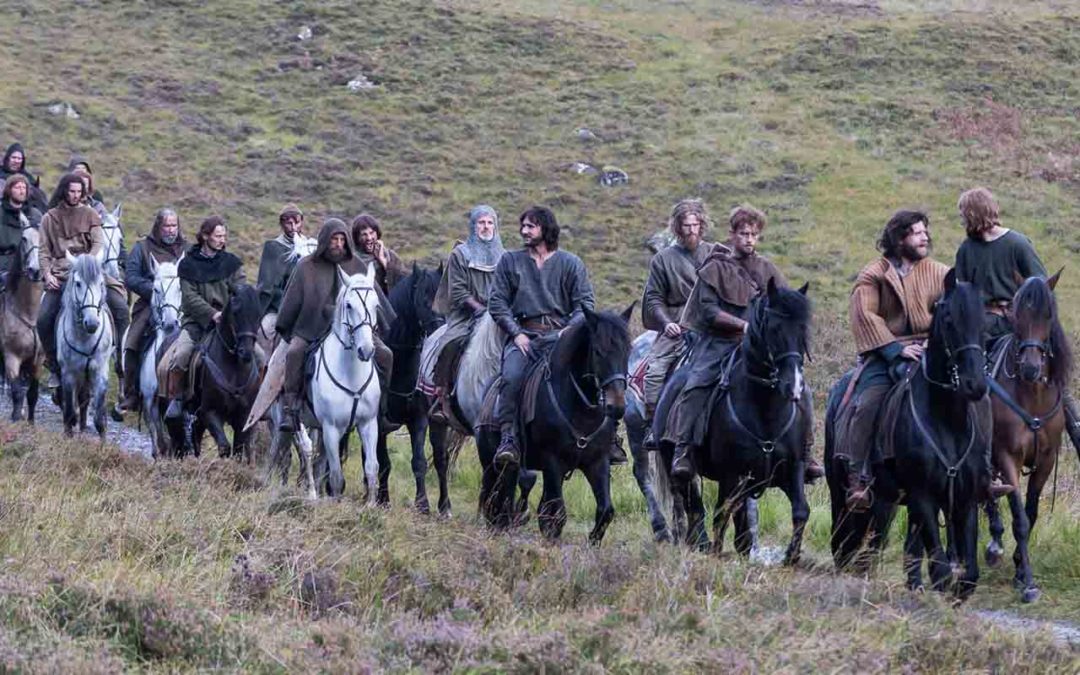By Iain MacInnes
In September, I found myself traipsing about Glen Nevis in the rain with a Polish film crew. There I spoke about the history and mythology of Mel Gibson’s 1995 blockbuster, Braveheart at one of the sites where it was filmed. I was reminded of the enormous impact that the film had both globally and here in Scotland. Indeed, when I first studied History at Glasgow, Professor Ted Cowan spent the first few lectures of the semester disavowing a significant portion of the undergraduate audience of Braveheart’s numerous falsehoods. The ’90s are back in cultural vogue, and so too historians may be about to enter into another phase of popular (mis)understanding about the Scottish Wars of Independence as a consequence of Hollywood forays into medieval Scottish history. Netflix has already released Outlaw King, directed by David Mackenzie and starring Chris Pine as King Robert I. And because it seems as if films about Scotland’s most iconic military-leader-turned-folk hero are like busses, another Bruce film is on the horizon: 2019 will see Angus Macfayden (who played Bruce in Braveheart) return to the iconic role in Robert the Bruce. Scotland’s medieval fight for independence will be alive in the popular consciousness once more.
These films are emerging at an interesting juncture. The growing reality of post-Brexit Britain is arguably encouraging many Scots to think again about the 2014 Scottish Independence Referendum. After all, the “Better Together” campaign promised Scots that remaining in the UK would ensure continued membership of the European Union. Calls for an “indyref2” continue – demanded at increasing numbers of pro-independence marches – even if First Minister Nicola Sturgeon is hedging her bets. The release of Outlaw King, which chronicles Bruce’s fight for his nation’s sovereignty, may well resonate with Scottish audiences for reasons beyond Pine’s star persona and the stunning Scottish landscapes on show. The Scottish National Party (SNP) certainly attempted to make hay with Braveheart’s release in 1995. And although the 2014 campaign notably rejected historical imagery for a campaign that looked to the future, the SNP may yet hope for a “Bruce bounce.”
Politics aside, much of the debate about historical films often focuses on their perceived (or lack of) “historical accuracy.” The trailer for another forthcoming historical drama, Mary Queen of Scots (2018), provoked just such a discussion. Outlaw King finds itself under similar scrutiny, although at present it is Chris Pine’s Scottish accent and penis that are attracting greatest attention. Still, hope was voiced that Outlaw King would dispel some of the myths created (or reinforced) by Braveheart, even if the reality is less clear. And yet the problem is that many of those myths have been around for a long time. After all, the history of Bruce is not new. While Outlaw King may sell itself as telling “the untold story” of Robert I, his tale is actually relatively well-known. Many people know something about the man himself, Bannockburn, or the Scottish Wars of Independence more generally.
For decades, the schoolchildren of Scotland have been shuttled to that bleak field outside Stirling to walk the (incorrect) site of Bruce’s most famous victory. Visitors since 2014 have been able to visit the National Trust for Scotland’s Battle of Bannockburn Experience and relive what it was actually like to be in the centre of the fight through the magic of technology. Moreover, Robert Bruce appeared in various forms of twentieth- and twenty-first-century popular culture beyond Braveheart. The Bruce (1996) attempted to exploit the ‘Braveheart buzz’ to continue Scotland’s medieval story on screen, but struggled to equal the critical and box-office success of its predecessor despite starring Oliver Reed and Brian Blessed. Bruce found a place in the Ladybird history books series with the volume Robert the Bruce (1964). Even earlier, Agnes Mure Mackenzie, historian and novelist, wrote the children’s book, I was at Bannockburn (1939). In comic form Bruce appeared recently in Tales of Wallace and Bruce (2017), On Dangerous Ground (2014), and (somewhat bizarrely) in an issue of X-Men spin-off The New Mutants (#47, January 1987, “My Heart for the Highlands”).
The idea of Bruce’s story being “untold” is, therefore, problematic. Indeed, it can be argued instead that Bruce’s story – or one particular version of it, at least – is in fact too well-known. That’s because many of the modern works – Outlaw King included – based their narratives on one particular medieval source: John Barbour’s epic poem, The Bruce. Written in the 1370s for the court of the new Stewart dynasty, The Bruce is both a fantastically entertaining and convincingly constructed account of the life of Robert Bruce. But it is also at the same time a very clever piece of propaganda, written in a specific historical context and for a specific audience of that time.
Barbour tailored his work, for example, to focus on particular families not necessarily because they were important in Bruce’s ascendance in the early 1300s, but because they were at the centre of Scottish political life in the 1370s. Consequently, the important families of Barbour’s age are given undue prominence in the Bruce/Bannockburn myth which positions the battle as all-important and Bruce’s kingship of Scotland as a necessary element in ensuring Scotland’s independence. Conversely, other notable Scottish families and individuals, including those who opposed Bruce, are either reduced in importance or removed altogether from Barbour’s narrative. And nothing at all is provided on what happened next, giving rise to yet another myth: that Bruce united Scotland in opposition to the English under his kingship and left it as a strong and unified kingdom upon his death.
The Bruce is a narrative that was intended to inspire. Just as the SNP may hope to see increasing nationalist sentiment on the back of Outlaw King’s release, Barbour too hoped for a patriotic response to his work. While war with England had been in abeyance through the latter years of the reign of David II (Robert I’s heir and successor), after David’s death, calls for the renewal of war increased. The Bruce was intended to recall and commemorate the heroism of those who had fought the English in 1306-1328 in order to encourage similar acts of chivalry and daring in a revived war with England.
So as various reviews and online comments about Outlaw King dwell on its “historical accuracy” (or its lack thereof) we should remember that our medieval sources, on which modern narratives are based, also lack “accuracy.” Both modern and medieval representations of the Wars of Independence are merely facsimiles of the past. They are not “fake news,” but neither are they “truth.” As Indiana Jones said, “if it’s truth you’re interested in, Dr Tyree’s Philosophy class is right down the hall.” Instead of looking for an unreachable truth, we as historians instead need to analyse what is said, what is depicted, and consider what it can tell us about our own period, and not just the fourteenth century.
 Dr Iain MacInnes is a Senior Lecturer at the Centre for History, University of the Highlands and Islands. He specialises in medieval warfare, chivalry, and its modern depiction. His book, Scotland’s Second War of Independence, 1332-1357, is published by Boydell and Brewer. Follow him on Twitter.
Dr Iain MacInnes is a Senior Lecturer at the Centre for History, University of the Highlands and Islands. He specialises in medieval warfare, chivalry, and its modern depiction. His book, Scotland’s Second War of Independence, 1332-1357, is published by Boydell and Brewer. Follow him on Twitter.

